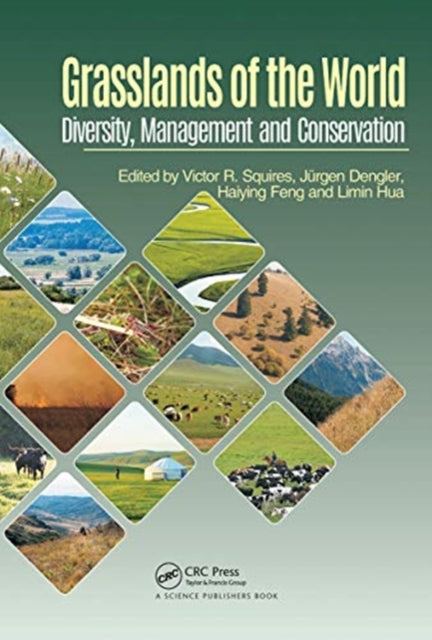Shulph Ink
Grasslands of the World: Diversity, Management and Conservation
Grasslands of the World: Diversity, Management and Conservation
YOU SAVE £2.31
- Condition: Brand new
- UK Delivery times: Usually arrives within 2 - 3 working days
- UK Shipping: Fee starts at £2.39. Subject to product weight & dimension
Bulk ordering. Want 15 or more copies? Get a personalised quote and bigger discounts. Learn more about bulk orders.
Couldn't load pickup availability
- More about Grasslands of the World: Diversity, Management and Conservation
This book explores the extraordinary sequence of events that led to the emergence of grasslands as a major vegetation formation, competing with forests and woodlands. It focuses on the Palaearctic biogeographic realm, which covers 45 million km² and is crucial for agriculture, ecosystem services, and biodiversity. Case studies are presented on various countries, examining the impacts of global climate change on grasslands and exploring management systems to ensure sustainability.
Format: Paperback / softback
Length: 426 pages
Publication date: 31 March 2021
Publisher: Taylor & Francis Ltd
This captivating book delves into the remarkable story of how grasslands emerged as dominant vegetation formations, thriving in some of the world's harshest and most diverse environments. It explores the intricate dynamics between grasses, grazing herbivores, humans, and the use of fire as a tool, showcasing their remarkable adaptability to changing climates and biophysical environments.
The book begins by providing a concise account of the series of events that led to the formation of grasslands, which now occupy vast expanses of the earth, ranging from arid deserts to icy tundras. It sheds light on how grasses successfully competed with forests and woodlands, aided by the presence of grazing herbivores and the influence of humans. This captivating narrative showcases the resilience and versatility of grasslands, as they adapt to changing conditions and thrive in diverse ecosystems.
A significant focus of the book is the Palaearctic biogeographic realm, which encompasses a vast expanse of approximately 45 million square kilometers, accounting for more than one-third of the terrestrial ice-free surface on Earth. Within this realm, grasslands of various types and origins can be found, each with its unique characteristics and adaptations. These grasslands can be categorized into two main groups: natural grasslands and secondary grasslands.
Natural grasslands include steppes, arctic-alpine grasslands, and azonal and extrazonal grasslands. Steppes, for instance, thrive in dry climates, while arctic-alpine grasslands are well-suited to cold environments. Azonal and extrazonal grasslands, on the other hand, are characterized by their pedogenic and topogenic origins, resulting from human activities such as livestock grazing, mowing, and burning. These secondary grasslands play a crucial role in supporting agriculture and providing food supplies in the region.
However, it is important to note that the suitability of grasslands for biodiversity depends heavily on their state. To recognize those grasslands that maintain their natural integrity and are not degraded, the term "High Nature Value grassland" is used. These natural grasslands are not only vital for the region's agriculture but also provide essential ecosystem services and harbor a disproportionate share of the world's plant and animal diversity.
The book also delves into the situation in various countries where grasslands are evolving under the influence of global climate change. It highlights the challenges and opportunities that these changes present, as well as the strategies that are being implemented to mitigate the negative impacts and preserve the ecological value of grasslands. The book emphasizes the importance of sustainable management practices, including conservation efforts, restoration projects, and the promotion of responsible land use practices.
In conclusion, this book offers a comprehensive and insightful exploration of the world of grasslands, their origins, adaptations, and significance in shaping the Earth's ecosystems. It sheds light on the complex interplay between grasses, grazing herbivores, humans, and fire, highlighting the remarkable resilience and versatility of these vital vegetation formations. The book also provides valuable insights into the Palaearctic biogeographic realm and the role of grasslands in supporting agriculture, providing ecosystem services, and preserving biodiversity. By highlighting the importance of sustainable management practices, this book serves as a call to action for preserving and protecting these valuable natural resources for future generations.
Weight: 785g
Dimension: 254 x 178 (mm)
ISBN-13: 9780367780937
This item can be found in:
UK and International shipping information
UK and International shipping information
UK Delivery and returns information:
- Delivery within 2 - 3 days when ordering in the UK.
- Shipping fee for UK customers from £2.39. Fully tracked shipping service available.
- Returns policy: Return within 30 days of receipt for full refund.
International deliveries:
Shulph Ink now ships to Australia, Belgium, Canada, France, Germany, Ireland, Italy, India, Luxembourg Saudi Arabia, Singapore, Spain, Netherlands, New Zealand, United Arab Emirates, United States of America.
- Delivery times: within 5 - 10 days for international orders.
- Shipping fee: charges vary for overseas orders. Only tracked services are available for most international orders. Some countries have untracked shipping options.
- Customs charges: If ordering to addresses outside the United Kingdom, you may or may not incur additional customs and duties fees during local delivery.


